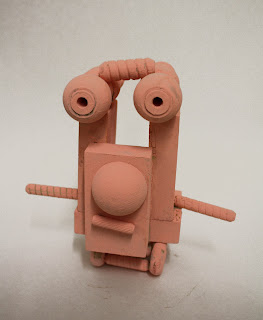Is it a vase, or a pencil holder? Could it be a box, or possibly a treasure chest? Whatever it might be, the ceramic slab sculpture is unique and original to the student that created it. In fourth grade, students built upon ceramic skills learned in years prior by creating three-dimensional slab sculptures. Students were responsible for making decisions regarding the size, shape, texture, and functionality of their sculpture. After creating paper templates to help measure the base and sides of their piece, students wedged clay, rolled slabs, cut slabs from templates, and constructed their piece with care. Finally, students glazed their sculptures using consistent coats of glaze. Voila!
Monday, April 16, 2012
Wednesday, April 11, 2012
Composition Activity
In third grade, as an introductory activity to our big still life project, I had students practice getting comfortable using a viewfinder. We first reviewed observational drawing, and some ways to get better at it. Then, we looked at the difference between open composition and closed composition. Students chose a few everyday art room objects from a box, and arranged them how they liked. Third graders were challenged to create two observational drawings using open composition for one, and closed composition for another. Enjoy a few samples below.
Louise Nevelson Assemblages
 For the next second grade project, students looked at Louise Nevelson, a Jewish American artist, for inspiration. She creates beautifully complex sculptures that she calls “assemblages.” Nevelson found most of her materials in alleys and dumpsters. She gave new purpose to what others deemed trash by turning them into works of art. Nevelson carefully arranged the pieces in her assemblages, and coated them with one color of paint to create a unified look. In second grade, students hunted through the “classroom dumpster (boxes of random craft wooden pieces)” to find their own materials. Then, they unified their assemblage by painting it in one color. In class, we talked about how her abstract sculptures can resemble different things to all of us. What do some of the sculptures below look like to you?
For the next second grade project, students looked at Louise Nevelson, a Jewish American artist, for inspiration. She creates beautifully complex sculptures that she calls “assemblages.” Nevelson found most of her materials in alleys and dumpsters. She gave new purpose to what others deemed trash by turning them into works of art. Nevelson carefully arranged the pieces in her assemblages, and coated them with one color of paint to create a unified look. In second grade, students hunted through the “classroom dumpster (boxes of random craft wooden pieces)” to find their own materials. Then, they unified their assemblage by painting it in one color. In class, we talked about how her abstract sculptures can resemble different things to all of us. What do some of the sculptures below look like to you?When it Rains, it Pours
As a smaller third grade lesson, sticking with the theme of storytelling, I read the students one of my all-time favorite childhood stories, Cloudy with a Chance of Meatballs. This story inspired our next project. With the weather being so funky lately, and seeing a fair amount of extreme weather happening all over the globe, I asked students to create illustrations of some wacky weather. I had students randomly choose a word from three different boxes marked: severe weather, themes, and settings. Students then had to create an imaginative drawing combining the three words.
 |
| Tornado, Desert, Theme: Flowers, Plants and Things |
 |
| Tornado, City, Theme: Flowers, Plants, and Things |
 |
| Hurricane, Garden, Theme: Insects |
Frank Lloyd Wright Art Glass Window Collages
In fifth grade, students explored the exceptional architect, Frank Lloyd Wright. It was fun to take a closer look at an influential architect with such a familiar name. We looked into his life and work, and focused heavily on the artistic and abstract stained glass windows. Similar to Wright, students looked for inspiration in their home state. Students chose a flower or plant native to Illinois as the subject for their own art glass window design. Students first experimented with several ways to abstract their plant. Second, they created a final sketch using the abstracted version of their plant. I asked students to design their window using a symmetrical or asymmetrical design. To create the final collage, students chose between 3 and 5 different colors of construction paper. Below are a few examples of the art glass window collages.
Subscribe to:
Posts (Atom)
















